ACBE100 Business Report: Bupa's CSR and Health and Wellbeing Goals
VerifiedAdded on 2022/10/17
|11
|1858
|14
Report
AI Summary
This business report examines the corporate social responsibility (CSR) issues faced by Bupa, an international healthcare and multi-insurance group, in relation to the Sustainable Development Goal (SDG) of health and wellbeing. The report identifies gender gap and equality as key CSR issues affecting health outcomes in Australia. It explores the impact of these issues through an analysis of scholarly articles, highlighting disparities in access to healthcare, menstrual hygiene management, and overall health statistics between genders. The report proposes solutions such as health campaigns, education, and policy changes to address gender inequality and improve health and wellbeing. Recommendations include aligning with human rights, tailoring programs to specific community needs, and organizing health campaigns to promote early diagnosis and preventative measures. The report emphasizes the importance of addressing discrimination and promoting equal access to healthcare to achieve the SDG of health and wellbeing.
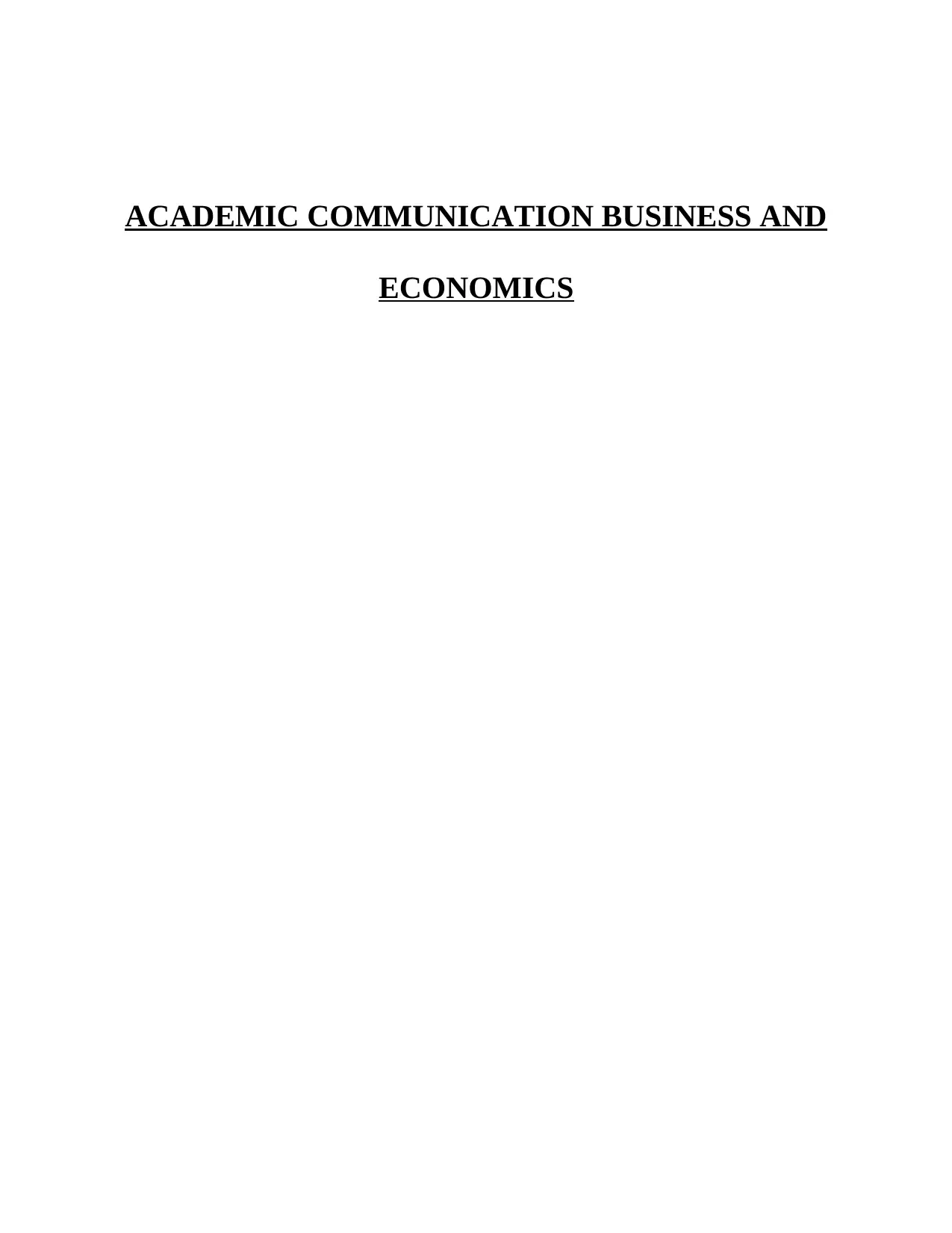
ACADEMIC COMMUNICATION BUSINESS AND
ECONOMICS
ECONOMICS
Paraphrase This Document
Need a fresh take? Get an instant paraphrase of this document with our AI Paraphraser
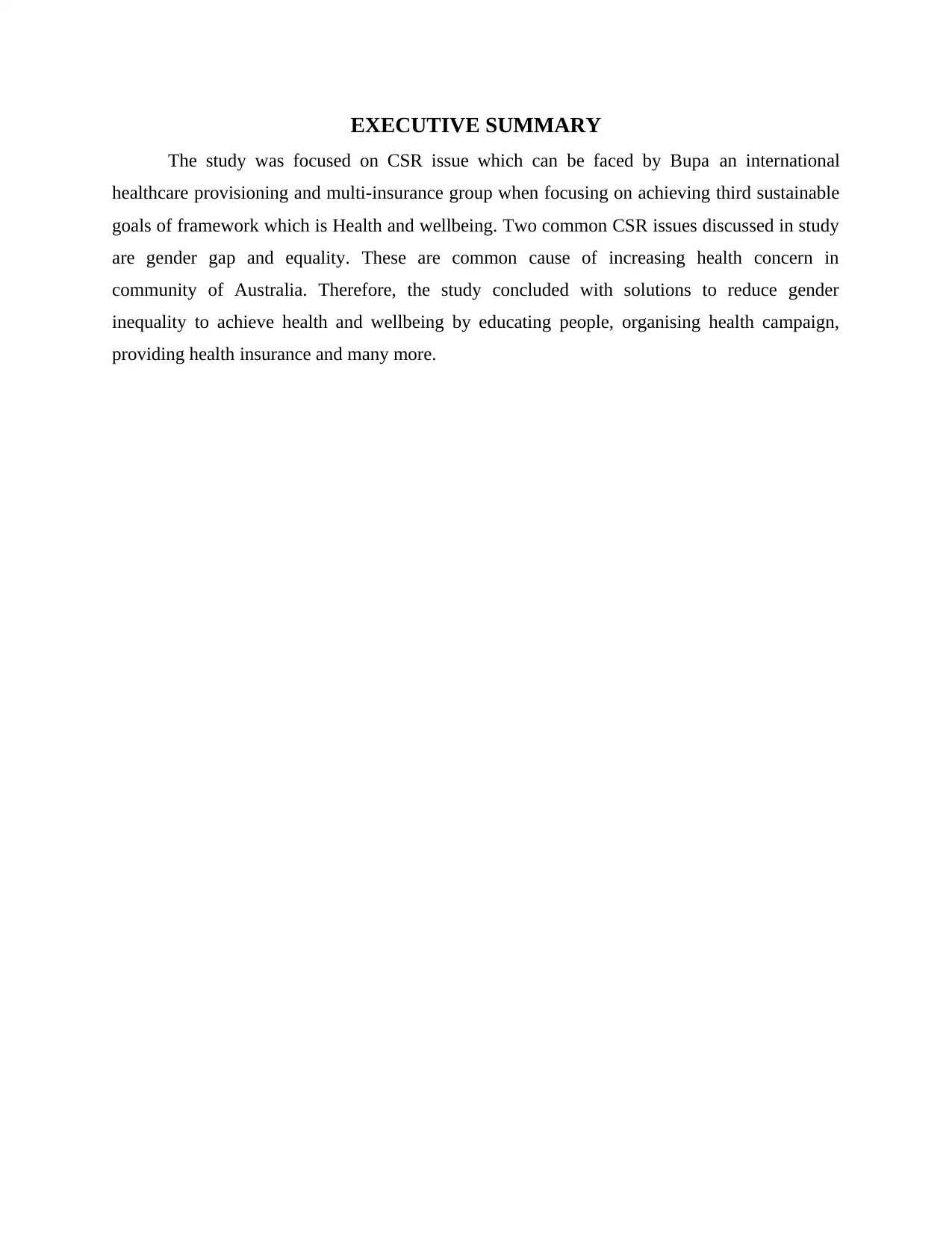
EXECUTIVE SUMMARY
The study was focused on CSR issue which can be faced by Bupa an international
healthcare provisioning and multi-insurance group when focusing on achieving third sustainable
goals of framework which is Health and wellbeing. Two common CSR issues discussed in study
are gender gap and equality. These are common cause of increasing health concern in
community of Australia. Therefore, the study concluded with solutions to reduce gender
inequality to achieve health and wellbeing by educating people, organising health campaign,
providing health insurance and many more.
The study was focused on CSR issue which can be faced by Bupa an international
healthcare provisioning and multi-insurance group when focusing on achieving third sustainable
goals of framework which is Health and wellbeing. Two common CSR issues discussed in study
are gender gap and equality. These are common cause of increasing health concern in
community of Australia. Therefore, the study concluded with solutions to reduce gender
inequality to achieve health and wellbeing by educating people, organising health campaign,
providing health insurance and many more.
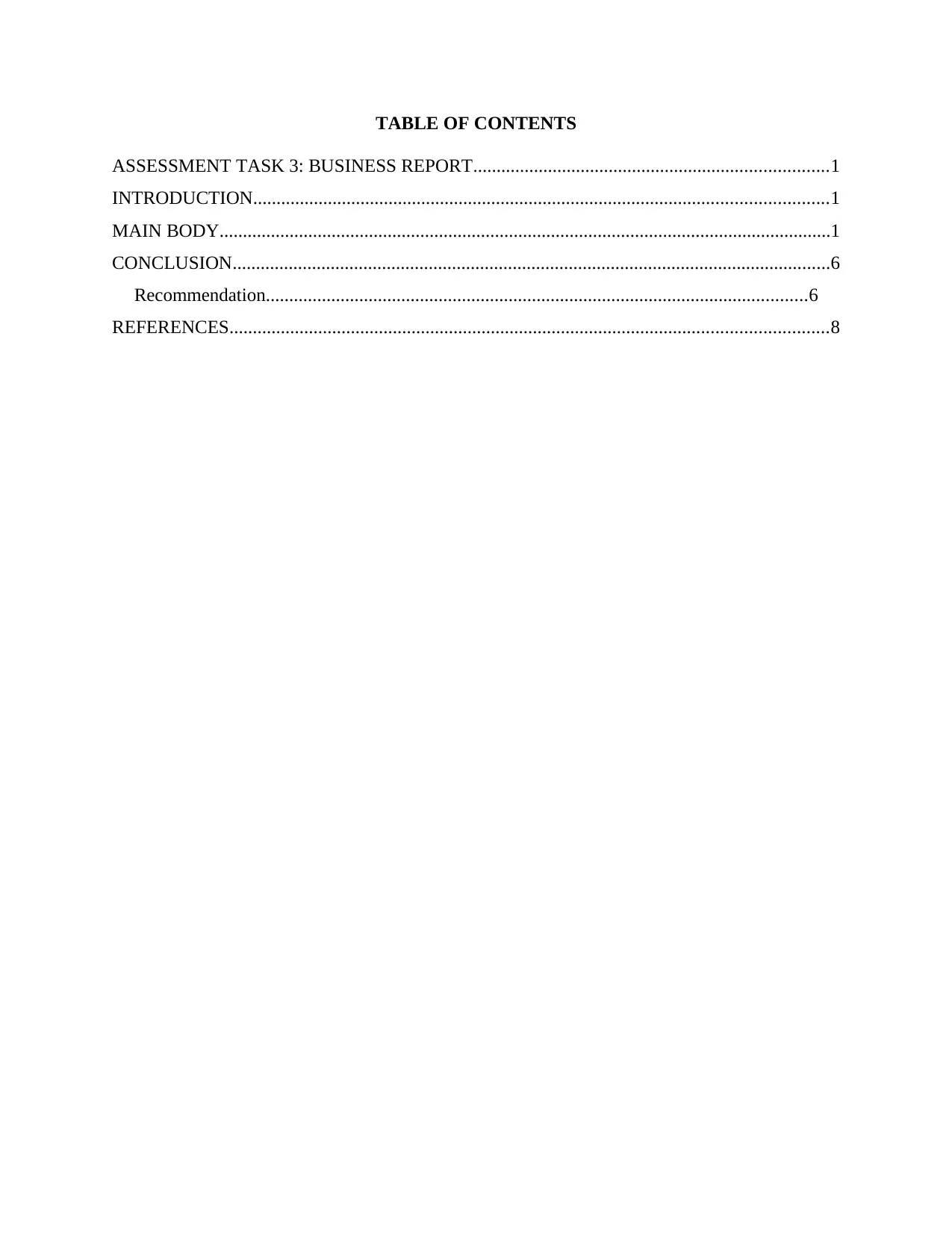
TABLE OF CONTENTS
ASSESSMENT TASK 3: BUSINESS REPORT............................................................................1
INTRODUCTION...........................................................................................................................1
MAIN BODY...................................................................................................................................1
CONCLUSION................................................................................................................................6
Recommendation....................................................................................................................6
REFERENCES................................................................................................................................8
ASSESSMENT TASK 3: BUSINESS REPORT............................................................................1
INTRODUCTION...........................................................................................................................1
MAIN BODY...................................................................................................................................1
CONCLUSION................................................................................................................................6
Recommendation....................................................................................................................6
REFERENCES................................................................................................................................8
⊘ This is a preview!⊘
Do you want full access?
Subscribe today to unlock all pages.

Trusted by 1+ million students worldwide
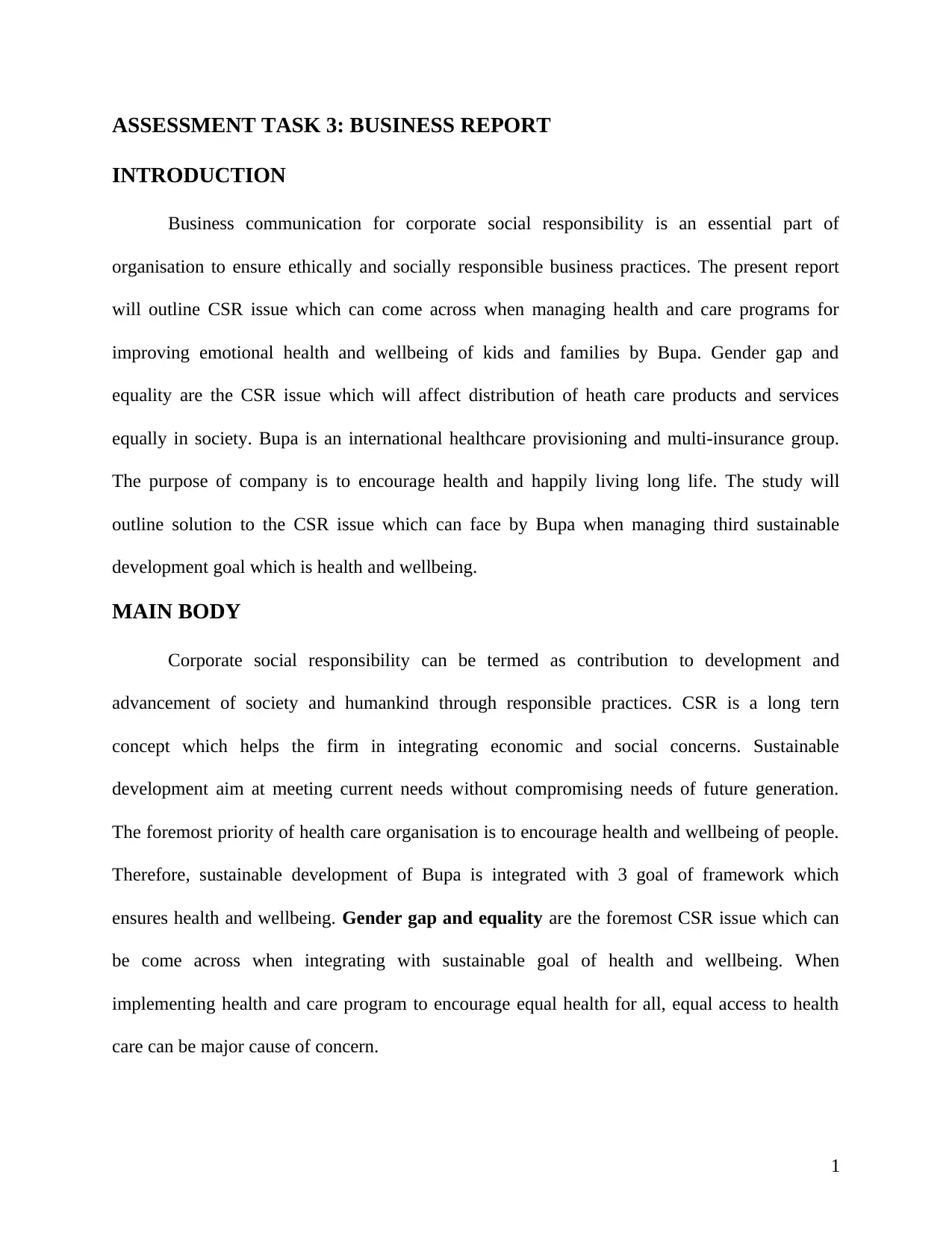
ASSESSMENT TASK 3: BUSINESS REPORT
INTRODUCTION
Business communication for corporate social responsibility is an essential part of
organisation to ensure ethically and socially responsible business practices. The present report
will outline CSR issue which can come across when managing health and care programs for
improving emotional health and wellbeing of kids and families by Bupa. Gender gap and
equality are the CSR issue which will affect distribution of heath care products and services
equally in society. Bupa is an international healthcare provisioning and multi-insurance group.
The purpose of company is to encourage health and happily living long life. The study will
outline solution to the CSR issue which can face by Bupa when managing third sustainable
development goal which is health and wellbeing.
MAIN BODY
Corporate social responsibility can be termed as contribution to development and
advancement of society and humankind through responsible practices. CSR is a long tern
concept which helps the firm in integrating economic and social concerns. Sustainable
development aim at meeting current needs without compromising needs of future generation.
The foremost priority of health care organisation is to encourage health and wellbeing of people.
Therefore, sustainable development of Bupa is integrated with 3 goal of framework which
ensures health and wellbeing. Gender gap and equality are the foremost CSR issue which can
be come across when integrating with sustainable goal of health and wellbeing. When
implementing health and care program to encourage equal health for all, equal access to health
care can be major cause of concern.
1
INTRODUCTION
Business communication for corporate social responsibility is an essential part of
organisation to ensure ethically and socially responsible business practices. The present report
will outline CSR issue which can come across when managing health and care programs for
improving emotional health and wellbeing of kids and families by Bupa. Gender gap and
equality are the CSR issue which will affect distribution of heath care products and services
equally in society. Bupa is an international healthcare provisioning and multi-insurance group.
The purpose of company is to encourage health and happily living long life. The study will
outline solution to the CSR issue which can face by Bupa when managing third sustainable
development goal which is health and wellbeing.
MAIN BODY
Corporate social responsibility can be termed as contribution to development and
advancement of society and humankind through responsible practices. CSR is a long tern
concept which helps the firm in integrating economic and social concerns. Sustainable
development aim at meeting current needs without compromising needs of future generation.
The foremost priority of health care organisation is to encourage health and wellbeing of people.
Therefore, sustainable development of Bupa is integrated with 3 goal of framework which
ensures health and wellbeing. Gender gap and equality are the foremost CSR issue which can
be come across when integrating with sustainable goal of health and wellbeing. When
implementing health and care program to encourage equal health for all, equal access to health
care can be major cause of concern.
1
Paraphrase This Document
Need a fresh take? Get an instant paraphrase of this document with our AI Paraphraser
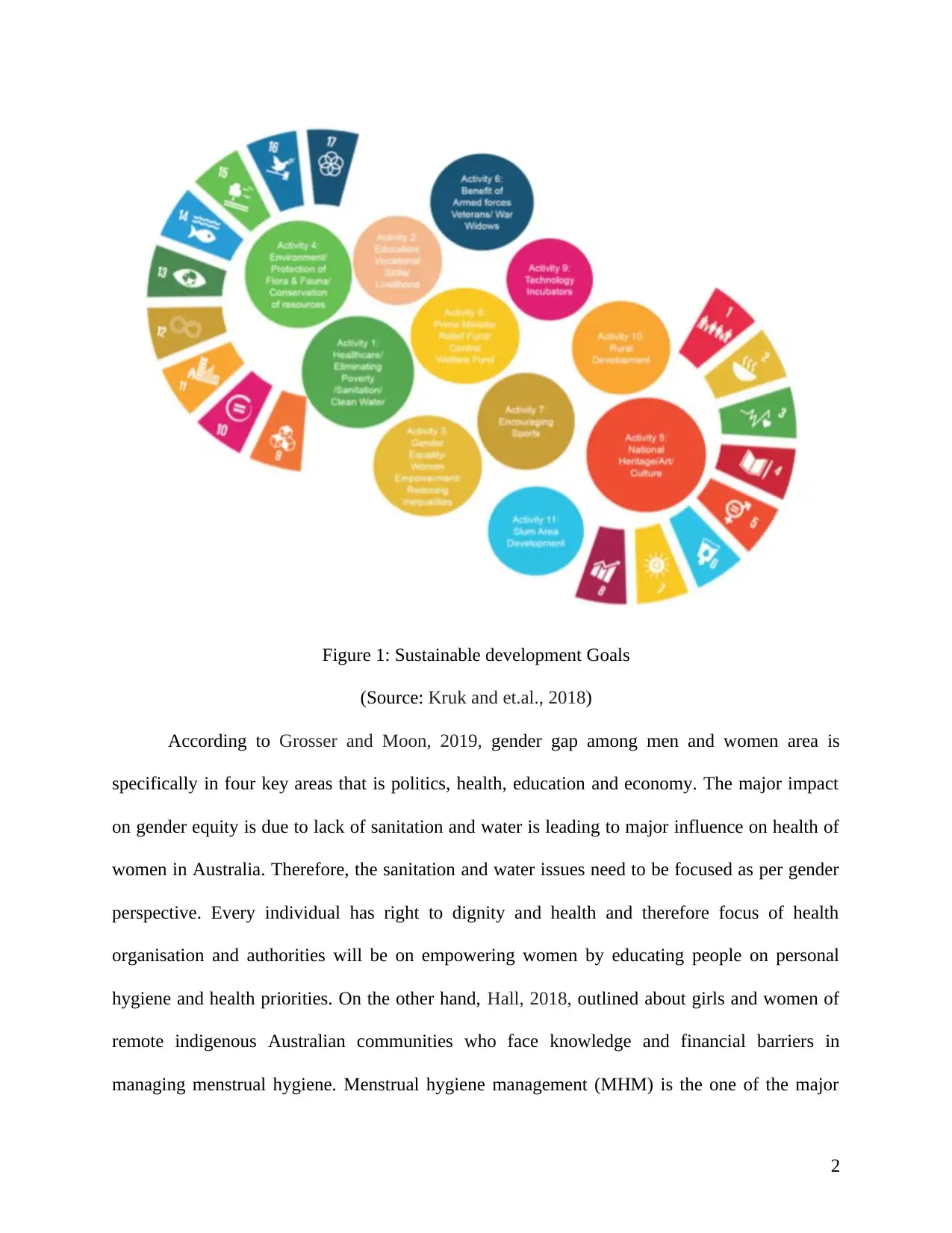
Figure 1: Sustainable development Goals
(Source: Kruk and et.al., 2018)
According to Grosser and Moon, 2019, gender gap among men and women area is
specifically in four key areas that is politics, health, education and economy. The major impact
on gender equity is due to lack of sanitation and water is leading to major influence on health of
women in Australia. Therefore, the sanitation and water issues need to be focused as per gender
perspective. Every individual has right to dignity and health and therefore focus of health
organisation and authorities will be on empowering women by educating people on personal
hygiene and health priorities. On the other hand, Hall, 2018, outlined about girls and women of
remote indigenous Australian communities who face knowledge and financial barriers in
managing menstrual hygiene. Menstrual hygiene management (MHM) is the one of the major
2
(Source: Kruk and et.al., 2018)
According to Grosser and Moon, 2019, gender gap among men and women area is
specifically in four key areas that is politics, health, education and economy. The major impact
on gender equity is due to lack of sanitation and water is leading to major influence on health of
women in Australia. Therefore, the sanitation and water issues need to be focused as per gender
perspective. Every individual has right to dignity and health and therefore focus of health
organisation and authorities will be on empowering women by educating people on personal
hygiene and health priorities. On the other hand, Hall, 2018, outlined about girls and women of
remote indigenous Australian communities who face knowledge and financial barriers in
managing menstrual hygiene. Menstrual hygiene management (MHM) is the one of the major
2
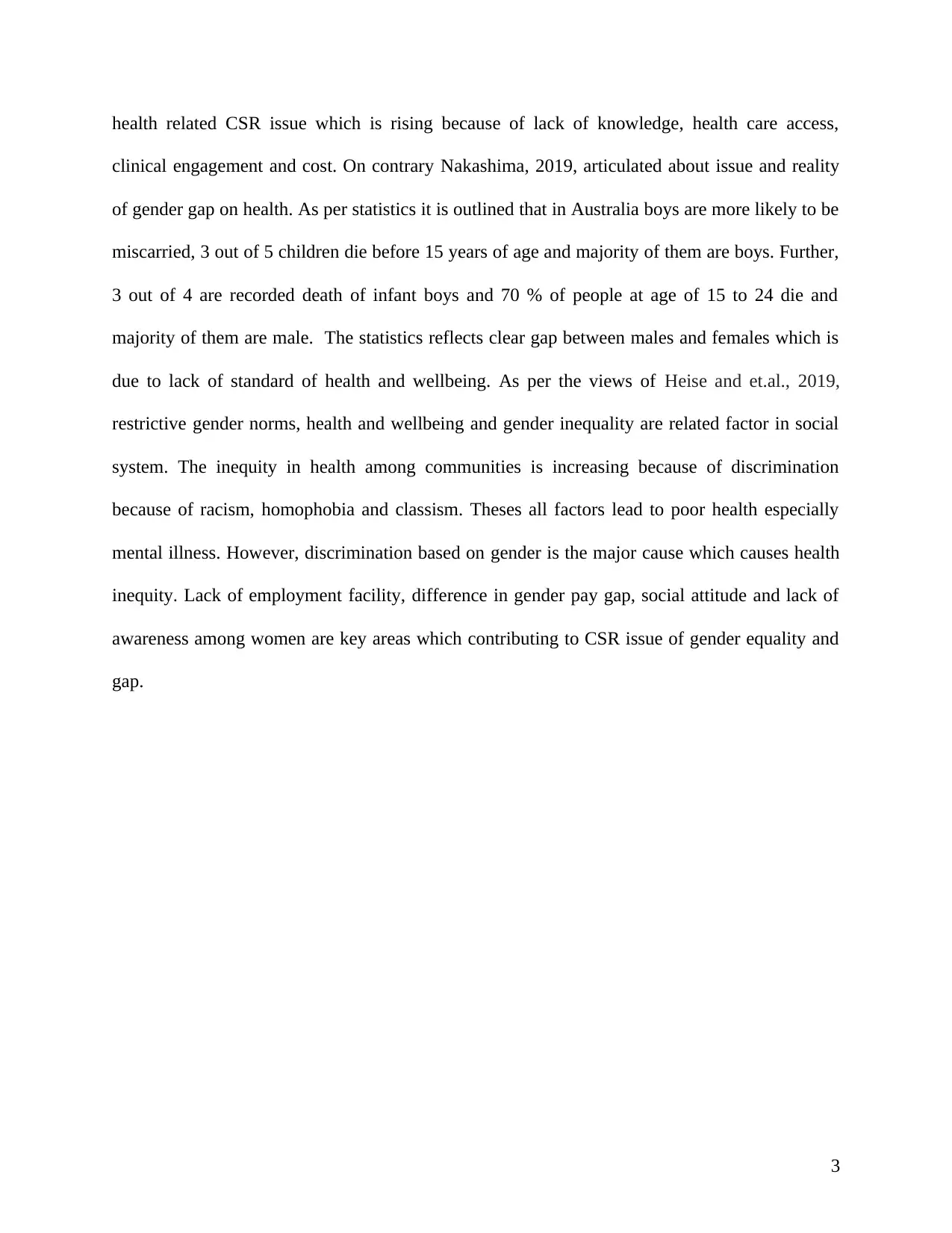
health related CSR issue which is rising because of lack of knowledge, health care access,
clinical engagement and cost. On contrary Nakashima, 2019, articulated about issue and reality
of gender gap on health. As per statistics it is outlined that in Australia boys are more likely to be
miscarried, 3 out of 5 children die before 15 years of age and majority of them are boys. Further,
3 out of 4 are recorded death of infant boys and 70 % of people at age of 15 to 24 die and
majority of them are male. The statistics reflects clear gap between males and females which is
due to lack of standard of health and wellbeing. As per the views of Heise and et.al., 2019,
restrictive gender norms, health and wellbeing and gender inequality are related factor in social
system. The inequity in health among communities is increasing because of discrimination
because of racism, homophobia and classism. Theses all factors lead to poor health especially
mental illness. However, discrimination based on gender is the major cause which causes health
inequity. Lack of employment facility, difference in gender pay gap, social attitude and lack of
awareness among women are key areas which contributing to CSR issue of gender equality and
gap.
3
clinical engagement and cost. On contrary Nakashima, 2019, articulated about issue and reality
of gender gap on health. As per statistics it is outlined that in Australia boys are more likely to be
miscarried, 3 out of 5 children die before 15 years of age and majority of them are boys. Further,
3 out of 4 are recorded death of infant boys and 70 % of people at age of 15 to 24 die and
majority of them are male. The statistics reflects clear gap between males and females which is
due to lack of standard of health and wellbeing. As per the views of Heise and et.al., 2019,
restrictive gender norms, health and wellbeing and gender inequality are related factor in social
system. The inequity in health among communities is increasing because of discrimination
because of racism, homophobia and classism. Theses all factors lead to poor health especially
mental illness. However, discrimination based on gender is the major cause which causes health
inequity. Lack of employment facility, difference in gender pay gap, social attitude and lack of
awareness among women are key areas which contributing to CSR issue of gender equality and
gap.
3
⊘ This is a preview!⊘
Do you want full access?
Subscribe today to unlock all pages.

Trusted by 1+ million students worldwide
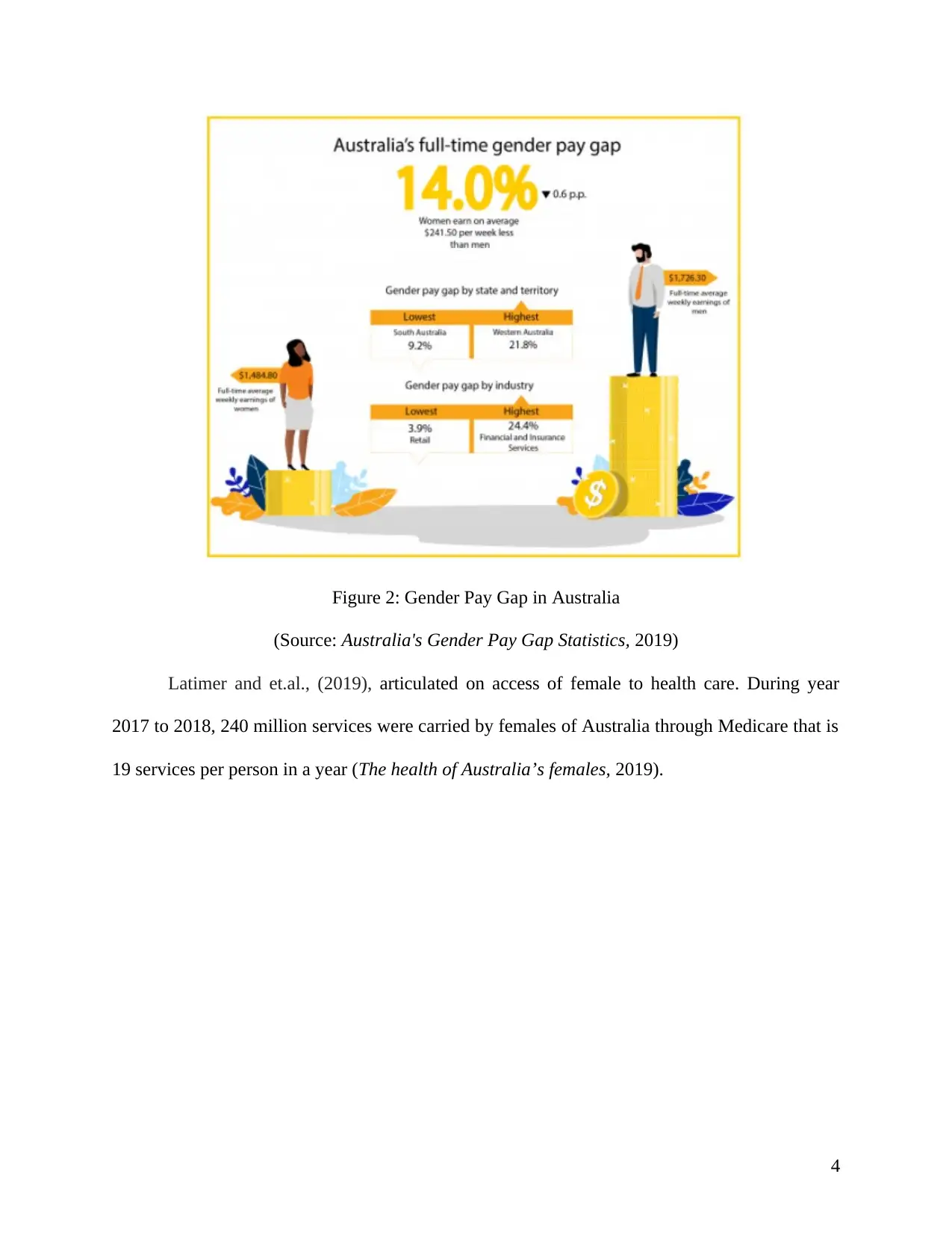
Figure 2: Gender Pay Gap in Australia
(Source: Australia's Gender Pay Gap Statistics, 2019)
Latimer and et.al., (2019), articulated on access of female to health care. During year
2017 to 2018, 240 million services were carried by females of Australia through Medicare that is
19 services per person in a year (The health of Australia’s females, 2019).
4
(Source: Australia's Gender Pay Gap Statistics, 2019)
Latimer and et.al., (2019), articulated on access of female to health care. During year
2017 to 2018, 240 million services were carried by females of Australia through Medicare that is
19 services per person in a year (The health of Australia’s females, 2019).
4
Paraphrase This Document
Need a fresh take? Get an instant paraphrase of this document with our AI Paraphraser
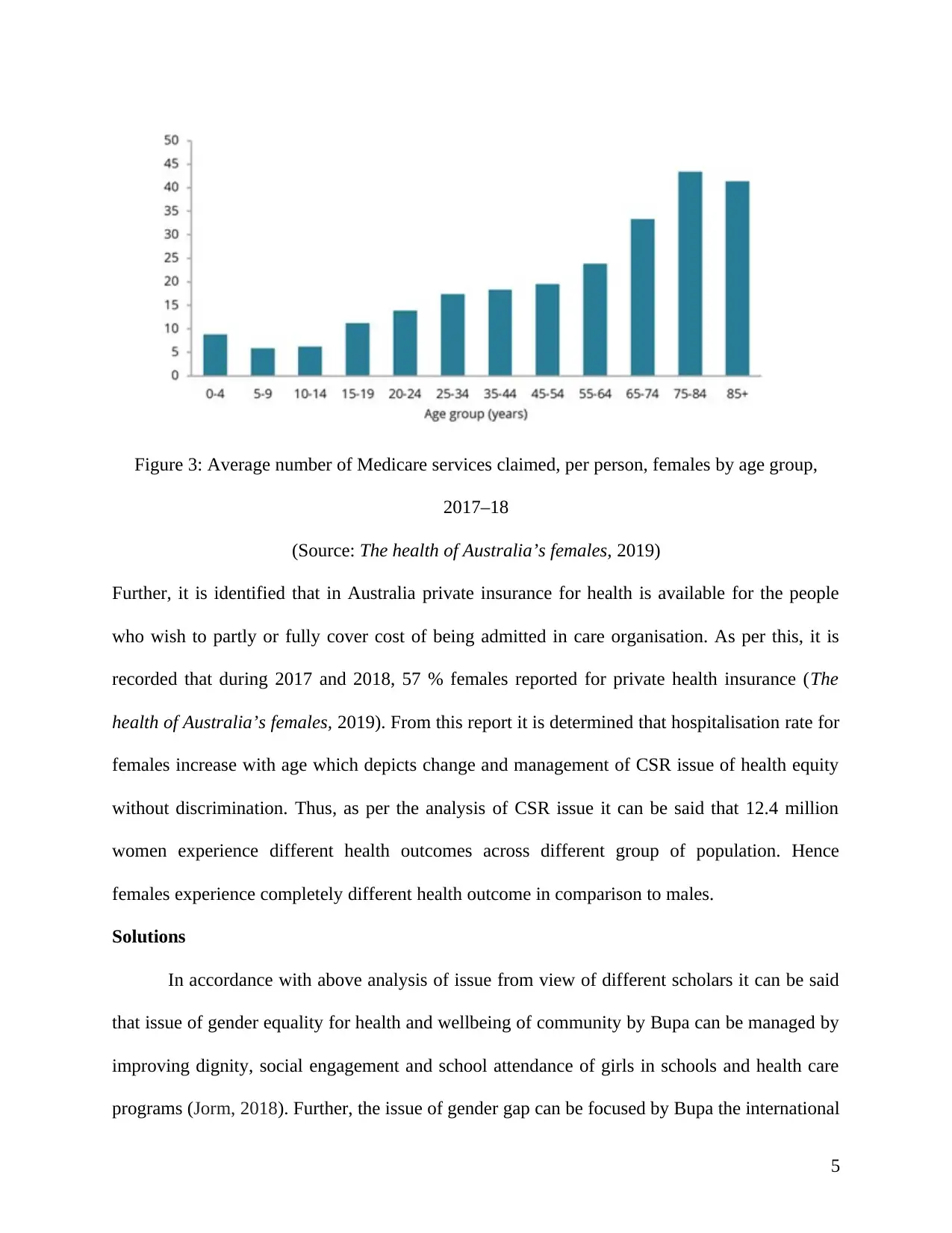
Figure 3: Average number of Medicare services claimed, per person, females by age group,
2017–18
(Source: The health of Australia’s females, 2019)
Further, it is identified that in Australia private insurance for health is available for the people
who wish to partly or fully cover cost of being admitted in care organisation. As per this, it is
recorded that during 2017 and 2018, 57 % females reported for private health insurance (The
health of Australia’s females, 2019). From this report it is determined that hospitalisation rate for
females increase with age which depicts change and management of CSR issue of health equity
without discrimination. Thus, as per the analysis of CSR issue it can be said that 12.4 million
women experience different health outcomes across different group of population. Hence
females experience completely different health outcome in comparison to males.
Solutions
In accordance with above analysis of issue from view of different scholars it can be said
that issue of gender equality for health and wellbeing of community by Bupa can be managed by
improving dignity, social engagement and school attendance of girls in schools and health care
programs (Jorm, 2018). Further, the issue of gender gap can be focused by Bupa the international
5
2017–18
(Source: The health of Australia’s females, 2019)
Further, it is identified that in Australia private insurance for health is available for the people
who wish to partly or fully cover cost of being admitted in care organisation. As per this, it is
recorded that during 2017 and 2018, 57 % females reported for private health insurance (The
health of Australia’s females, 2019). From this report it is determined that hospitalisation rate for
females increase with age which depicts change and management of CSR issue of health equity
without discrimination. Thus, as per the analysis of CSR issue it can be said that 12.4 million
women experience different health outcomes across different group of population. Hence
females experience completely different health outcome in comparison to males.
Solutions
In accordance with above analysis of issue from view of different scholars it can be said
that issue of gender equality for health and wellbeing of community by Bupa can be managed by
improving dignity, social engagement and school attendance of girls in schools and health care
programs (Jorm, 2018). Further, the issue of gender gap can be focused by Bupa the international
5
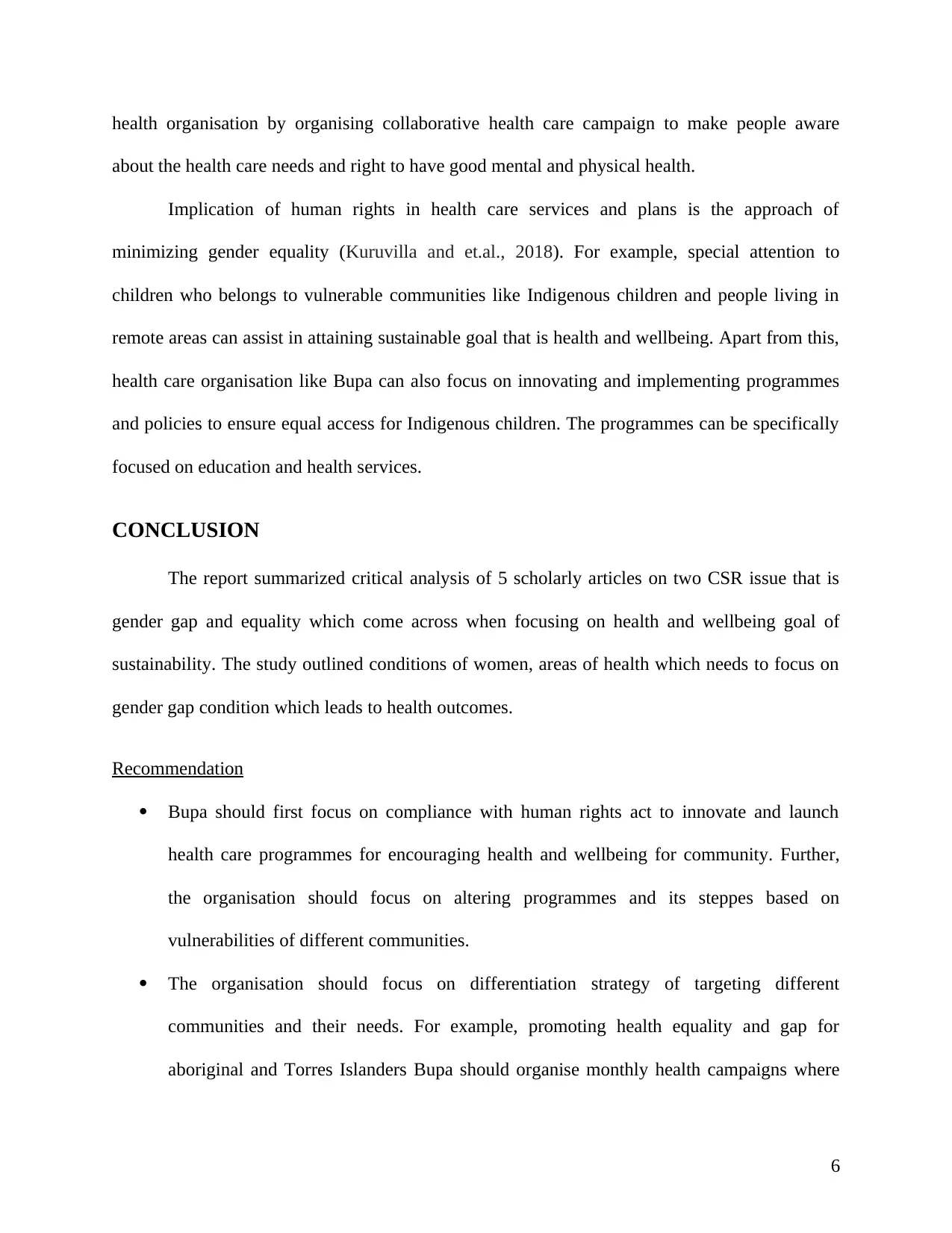
health organisation by organising collaborative health care campaign to make people aware
about the health care needs and right to have good mental and physical health.
Implication of human rights in health care services and plans is the approach of
minimizing gender equality (Kuruvilla and et.al., 2018). For example, special attention to
children who belongs to vulnerable communities like Indigenous children and people living in
remote areas can assist in attaining sustainable goal that is health and wellbeing. Apart from this,
health care organisation like Bupa can also focus on innovating and implementing programmes
and policies to ensure equal access for Indigenous children. The programmes can be specifically
focused on education and health services.
CONCLUSION
The report summarized critical analysis of 5 scholarly articles on two CSR issue that is
gender gap and equality which come across when focusing on health and wellbeing goal of
sustainability. The study outlined conditions of women, areas of health which needs to focus on
gender gap condition which leads to health outcomes.
Recommendation
Bupa should first focus on compliance with human rights act to innovate and launch
health care programmes for encouraging health and wellbeing for community. Further,
the organisation should focus on altering programmes and its steppes based on
vulnerabilities of different communities.
The organisation should focus on differentiation strategy of targeting different
communities and their needs. For example, promoting health equality and gap for
aboriginal and Torres Islanders Bupa should organise monthly health campaigns where
6
about the health care needs and right to have good mental and physical health.
Implication of human rights in health care services and plans is the approach of
minimizing gender equality (Kuruvilla and et.al., 2018). For example, special attention to
children who belongs to vulnerable communities like Indigenous children and people living in
remote areas can assist in attaining sustainable goal that is health and wellbeing. Apart from this,
health care organisation like Bupa can also focus on innovating and implementing programmes
and policies to ensure equal access for Indigenous children. The programmes can be specifically
focused on education and health services.
CONCLUSION
The report summarized critical analysis of 5 scholarly articles on two CSR issue that is
gender gap and equality which come across when focusing on health and wellbeing goal of
sustainability. The study outlined conditions of women, areas of health which needs to focus on
gender gap condition which leads to health outcomes.
Recommendation
Bupa should first focus on compliance with human rights act to innovate and launch
health care programmes for encouraging health and wellbeing for community. Further,
the organisation should focus on altering programmes and its steppes based on
vulnerabilities of different communities.
The organisation should focus on differentiation strategy of targeting different
communities and their needs. For example, promoting health equality and gap for
aboriginal and Torres Islanders Bupa should organise monthly health campaigns where
6
⊘ This is a preview!⊘
Do you want full access?
Subscribe today to unlock all pages.

Trusted by 1+ million students worldwide
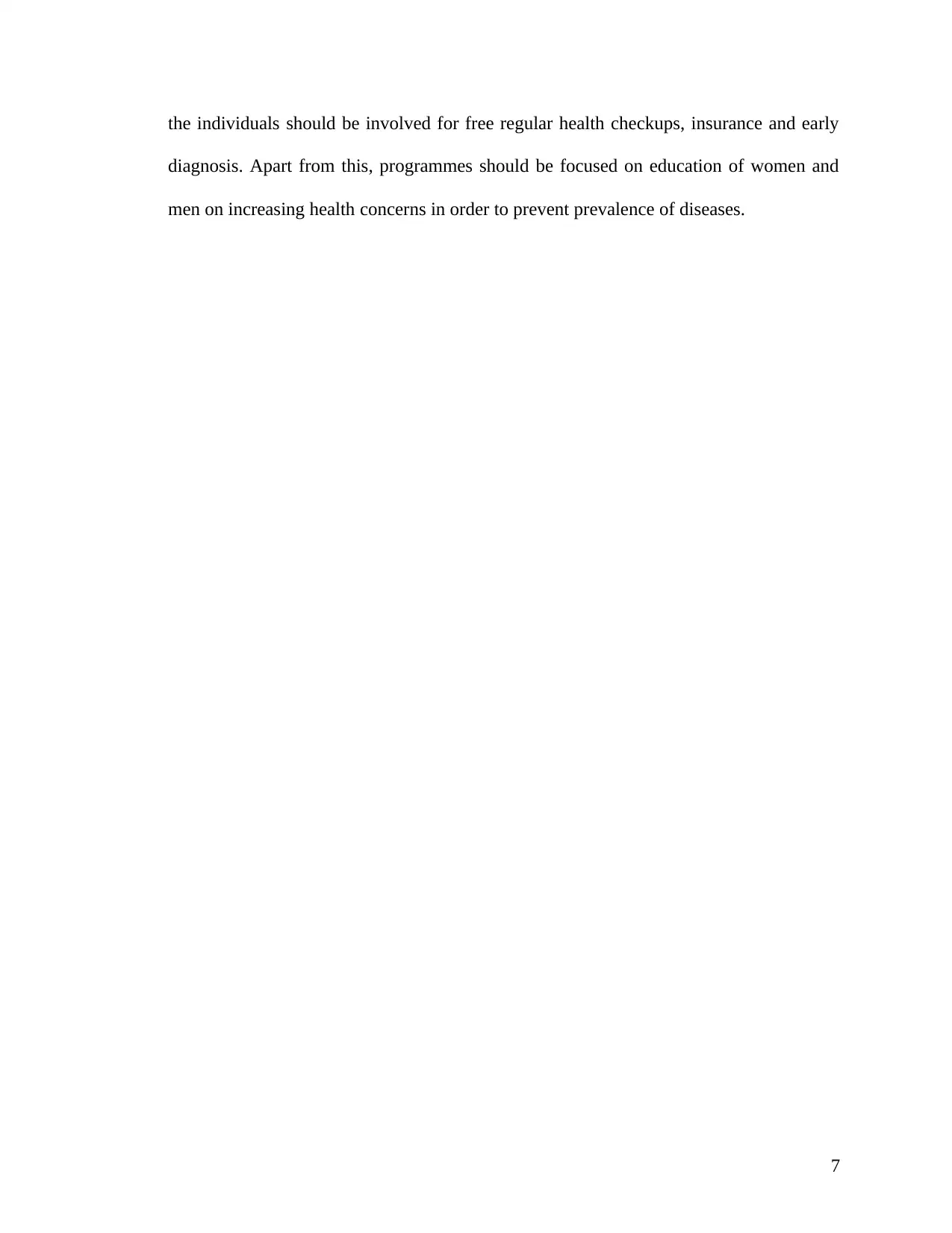
the individuals should be involved for free regular health checkups, insurance and early
diagnosis. Apart from this, programmes should be focused on education of women and
men on increasing health concerns in order to prevent prevalence of diseases.
7
diagnosis. Apart from this, programmes should be focused on education of women and
men on increasing health concerns in order to prevent prevalence of diseases.
7
Paraphrase This Document
Need a fresh take? Get an instant paraphrase of this document with our AI Paraphraser
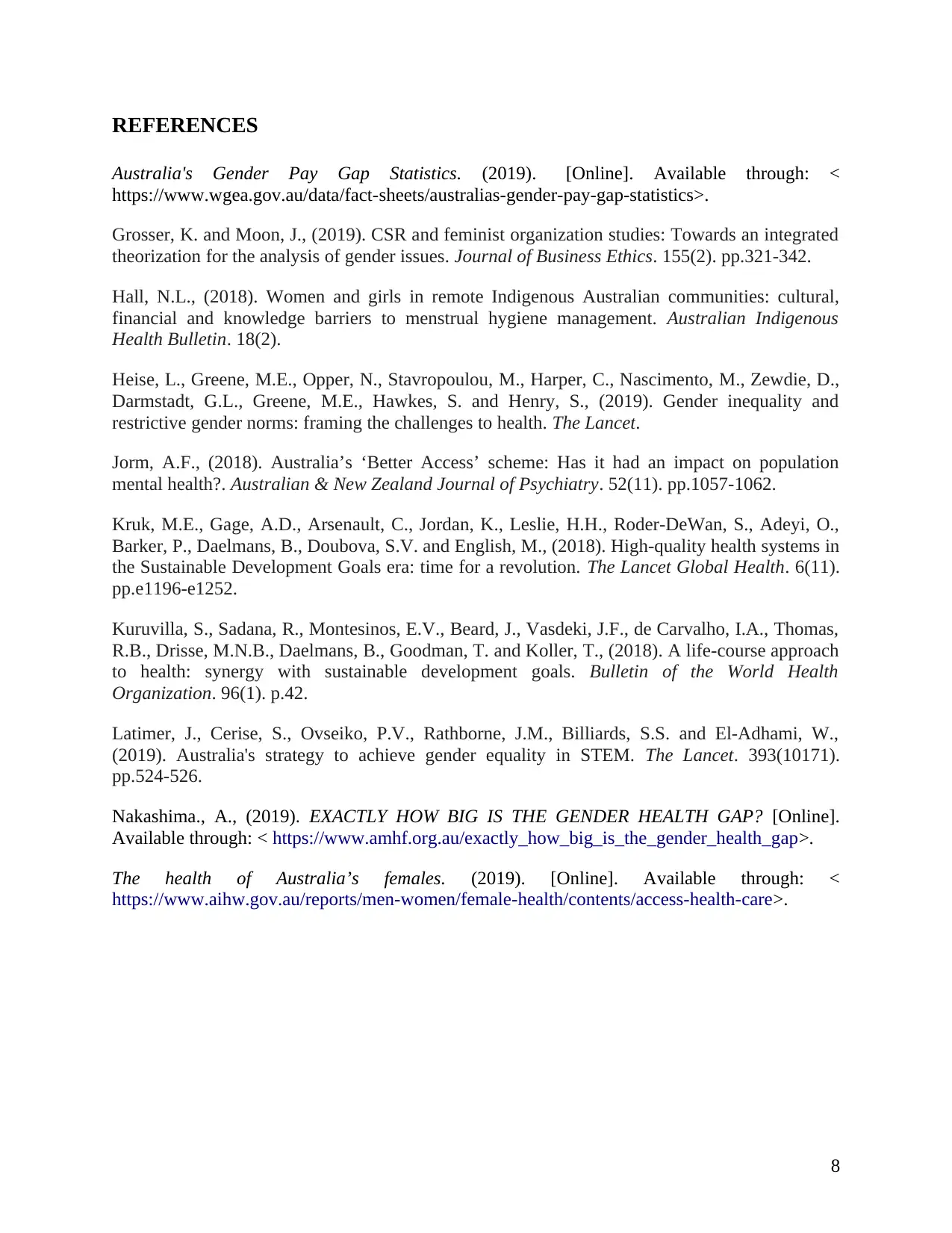
REFERENCES
Australia's Gender Pay Gap Statistics. (2019). [Online]. Available through: <
https://www.wgea.gov.au/data/fact-sheets/australias-gender-pay-gap-statistics>.
Grosser, K. and Moon, J., (2019). CSR and feminist organization studies: Towards an integrated
theorization for the analysis of gender issues. Journal of Business Ethics. 155(2). pp.321-342.
Hall, N.L., (2018). Women and girls in remote Indigenous Australian communities: cultural,
financial and knowledge barriers to menstrual hygiene management. Australian Indigenous
Health Bulletin. 18(2).
Heise, L., Greene, M.E., Opper, N., Stavropoulou, M., Harper, C., Nascimento, M., Zewdie, D.,
Darmstadt, G.L., Greene, M.E., Hawkes, S. and Henry, S., (2019). Gender inequality and
restrictive gender norms: framing the challenges to health. The Lancet.
Jorm, A.F., (2018). Australia’s ‘Better Access’ scheme: Has it had an impact on population
mental health?. Australian & New Zealand Journal of Psychiatry. 52(11). pp.1057-1062.
Kruk, M.E., Gage, A.D., Arsenault, C., Jordan, K., Leslie, H.H., Roder-DeWan, S., Adeyi, O.,
Barker, P., Daelmans, B., Doubova, S.V. and English, M., (2018). High-quality health systems in
the Sustainable Development Goals era: time for a revolution. The Lancet Global Health. 6(11).
pp.e1196-e1252.
Kuruvilla, S., Sadana, R., Montesinos, E.V., Beard, J., Vasdeki, J.F., de Carvalho, I.A., Thomas,
R.B., Drisse, M.N.B., Daelmans, B., Goodman, T. and Koller, T., (2018). A life-course approach
to health: synergy with sustainable development goals. Bulletin of the World Health
Organization. 96(1). p.42.
Latimer, J., Cerise, S., Ovseiko, P.V., Rathborne, J.M., Billiards, S.S. and El-Adhami, W.,
(2019). Australia's strategy to achieve gender equality in STEM. The Lancet. 393(10171).
pp.524-526.
Nakashima., A., (2019). EXACTLY HOW BIG IS THE GENDER HEALTH GAP? [Online].
Available through: < https://www.amhf.org.au/exactly_how_big_is_the_gender_health_gap>.
The health of Australia’s females. (2019). [Online]. Available through: <
https://www.aihw.gov.au/reports/men-women/female-health/contents/access-health-care>.
8
Australia's Gender Pay Gap Statistics. (2019). [Online]. Available through: <
https://www.wgea.gov.au/data/fact-sheets/australias-gender-pay-gap-statistics>.
Grosser, K. and Moon, J., (2019). CSR and feminist organization studies: Towards an integrated
theorization for the analysis of gender issues. Journal of Business Ethics. 155(2). pp.321-342.
Hall, N.L., (2018). Women and girls in remote Indigenous Australian communities: cultural,
financial and knowledge barriers to menstrual hygiene management. Australian Indigenous
Health Bulletin. 18(2).
Heise, L., Greene, M.E., Opper, N., Stavropoulou, M., Harper, C., Nascimento, M., Zewdie, D.,
Darmstadt, G.L., Greene, M.E., Hawkes, S. and Henry, S., (2019). Gender inequality and
restrictive gender norms: framing the challenges to health. The Lancet.
Jorm, A.F., (2018). Australia’s ‘Better Access’ scheme: Has it had an impact on population
mental health?. Australian & New Zealand Journal of Psychiatry. 52(11). pp.1057-1062.
Kruk, M.E., Gage, A.D., Arsenault, C., Jordan, K., Leslie, H.H., Roder-DeWan, S., Adeyi, O.,
Barker, P., Daelmans, B., Doubova, S.V. and English, M., (2018). High-quality health systems in
the Sustainable Development Goals era: time for a revolution. The Lancet Global Health. 6(11).
pp.e1196-e1252.
Kuruvilla, S., Sadana, R., Montesinos, E.V., Beard, J., Vasdeki, J.F., de Carvalho, I.A., Thomas,
R.B., Drisse, M.N.B., Daelmans, B., Goodman, T. and Koller, T., (2018). A life-course approach
to health: synergy with sustainable development goals. Bulletin of the World Health
Organization. 96(1). p.42.
Latimer, J., Cerise, S., Ovseiko, P.V., Rathborne, J.M., Billiards, S.S. and El-Adhami, W.,
(2019). Australia's strategy to achieve gender equality in STEM. The Lancet. 393(10171).
pp.524-526.
Nakashima., A., (2019). EXACTLY HOW BIG IS THE GENDER HEALTH GAP? [Online].
Available through: < https://www.amhf.org.au/exactly_how_big_is_the_gender_health_gap>.
The health of Australia’s females. (2019). [Online]. Available through: <
https://www.aihw.gov.au/reports/men-women/female-health/contents/access-health-care>.
8
1 out of 11
Related Documents
Your All-in-One AI-Powered Toolkit for Academic Success.
+13062052269
info@desklib.com
Available 24*7 on WhatsApp / Email
![[object Object]](/_next/static/media/star-bottom.7253800d.svg)
Unlock your academic potential
Copyright © 2020–2025 A2Z Services. All Rights Reserved. Developed and managed by ZUCOL.





